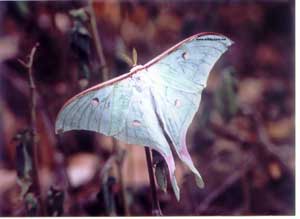-Dr. Susan Sharma
Did you know moths use perfume to attract their mate? This one's life history is quite bizarre. It goes through adult life without eating anything.
The Moon moth : The most obvious feature of this handsome moth is the long tail that adorns each hind wing. Many of the silk moths are named after mythological Greek figures. The luna moth or moon moth is named after
the moon. Silk moths do not eat or drink as adults. The moths don't even have mouths. All the eating is done as a caterpillar. The caterpillar must eat enough food to allow it the energy to spin a cocoon, transform into a moth and then to give the moth enough
stored energy to survive for approximately 1 week after hatching from the cocoon. It's not surprising, therefore, that silk moth caterpillars EAT A LOT!
 A female moon moth will lay between 200-300 eggs over a two day period. Soon thereafter she will die. Eggs will hatch within 10 days. The larval stage generally takes between 30-42 days. Each larva will progress through 5 stages,
punctuated by molts. An insect's skin does not grow along with its body! It stretches until it cannot stretch any further. Then the larva will become quiet for a time and eventually molt or shed its skin. The caterpillar can then start eating again. Mature
moon larvae can be 3- 4 inches in length. When the larva is fully mature, it will begin to spin a silk cocoon around itself, often using leaves as added camouflage. The silk is spun from silk glands at the mouth end of the larva. Once the cocoon has been spun,
the larva will shed its skin inside the cocoon for the last time, becoming a pupa. Inside the cocoon, the pupa will complete its development into a moth.
A female moon moth will lay between 200-300 eggs over a two day period. Soon thereafter she will die. Eggs will hatch within 10 days. The larval stage generally takes between 30-42 days. Each larva will progress through 5 stages,
punctuated by molts. An insect's skin does not grow along with its body! It stretches until it cannot stretch any further. Then the larva will become quiet for a time and eventually molt or shed its skin. The caterpillar can then start eating again. Mature
moon larvae can be 3- 4 inches in length. When the larva is fully mature, it will begin to spin a silk cocoon around itself, often using leaves as added camouflage. The silk is spun from silk glands at the mouth end of the larva. Once the cocoon has been spun,
the larva will shed its skin inside the cocoon for the last time, becoming a pupa. Inside the cocoon, the pupa will complete its development into a moth.
After about 4 weeks, the moth will push its way through the cocoon and emerge, its wings still tiny. The moth must then climb up some kind of support and pump fluid into its wings making them expand to their full size. Gravity helps
the wings to expand. After about 1 hour the moth will have completed its wing expansion and will wait until nightfall before becoming active. Moths will often sit for several days, as they wait for a male to find them. The tails of the moon moth are thought
to act as a lure for predators such that any would be predator getting close enough will be drawn away from the body.The male moths respond to a chemical mixture called a pheromone that is released by the females.Males use their large branched
antennae (See the photograph above)to detect this chemical in the air and they follow this chemical trail often for miles to find the source, the female moth. The female moth has only a few days to find a mate. After 3-4 days she will begin laying infertile
eggs whether or not she has mated.
( Photograph of moon moth by Jayant Deshpande.
Click here to see more photographs by Jayant )